1955 Thunderbird
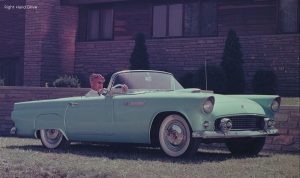
The 1955 Thunderbird was more of a personal car concept than a sports car, the result of a decision Crusoe made during the winter of 1953-54. The more luxurious direction created the personal luxury car segment of the automotive market, and Thunderbird would enjoy almost uninterrupted leadership in this segment for decades.
The original Thunderbird was a racy two-seater with clean, crisp lines on a 102-inch wheel base. Overall length was 175 inches, height was a low 52 inches, and the car was 70 inches wide. Standard curb weight was 3,180 pounds.
The base sticker price of $2,695, included the removable hardtop, but not the soft top. Clock, tachometer, power-operated seats and a 292 CID V-8 engine also were standard equipment. However, practically none of the early Thunderbirds left the dealership without either overdrive or automatic transmission and most of the power options. Prices of the 1955 models ranged from $3,000 to $4,000.
The car was an immediate smash hit. Buyers of all ages, from all walks of life described the car in terms such as “wonderful,” a “masterpiece,” “advanced automobile” and a “morale builder that is real fun and sport to drive.”
One letter even revealed that, after having viewed a magazine illustration, the admirer instructed an American relative to buy the 1955 Thunderbird and ship it to him in Europe.
The magic of the name and the impact of the car made it a natural merchandising tie-in for manufacturers of a wide range of goods – coats, jackets, shirts, shoes, rugs, furniture and toys, to name a few. Magazines also featured the Thunderbird in promotional campaigns. Some of the more prominent activities included:
The Powercar Company of Connecticut offered a Thunderbird Junior, a mechanically operated scale model car youngsters could drive.
Mechanix Illustrated offered Thunderbird as the first prize in their 1955 Build Words contest.
Cluett-Peabody used the Thunderbird to promote and sell Arrow shirts.
Worsted-Tex marketed Thunderbird-inspired coats, and many other clothiers used the car in promotions.
The public went for the Thunderbird in a big way, placing more than 3,500 orders in the first 10-day selling period. The planning volume for the entire model year was only 10,000 units. Ford had explored an uncharted market for unique transportation and came up with a winner.
The 1956 Thunderbird

With all of its popularity, the flight of the two-seater Thunderbird would be a short one. There were changes almost immediately after the car was introduced. The original design presented some problems. The cockpit needed better ventilation. Rear-quarter vision had to be improved. More trunk space was a necessity.
Design changes on 1956 models corrected these deficiencies. Flip-out side vents provided better ventilation, porthole windows enhanced rear vision and an outside tire carrier added trunk space. In addition, the 1956 Thunderbird featured Ford’s new safety concept of “packaging the passengers.”
Standard equipment included energy-absorbing instrument panel padding, a concave safety steering wheel, safety door latches and a shatter-resistant mirror. Safety belts were optional.
Last-minute improvements, including the addition of the optional 312 CID V-8 engine, gave the second edition of the Thunderbird better handling and increased performance.
1957 Thunderbird
The 1957 Thunderbird was the first to have a fully padded dash surface. It featured optional Dial-O-Matic power seats and a radio that automatically adjusted the volume in proportion to the speed of the engine.
It would be the last of the two-seaters. With production of 1958 models delayed, 1957 Thunderbird production continued for three extra months.
The last one rolled off the assembly line December 13, 1957. An era had ended.
The First Thunderbird
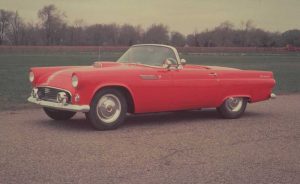
Two men, Louis D. Crusoe and George Walker, were primarily responsible for the birth of the Thunderbird. Both were devoted to the automobile and its constant development and refinement. Crusoe, a millionaire lured out of retirement by Henry Ford II, was a businessman with a solid “feel” for the automobile market. As a Ford vice president and Ford Division general manager, it was his responsibility to strengthen a young Ford Division . His goal was to give it a car that breathed excitement, a car that would add prestige to the Ford name. Walker, later a Ford vice president and chief stylist, is described by contemporaries as a “stylist with the soul of an artist burning in his heart.”
It was October 1951. With their mission in mind, the two men were walking along the aisles of the Grand Palais in Paris when Crusoe gestured toward one of the sportier automobiles on display, turned to Walker and asked: “Why can’t we have something like that?”
“We have a job just like that in the works right now,” was Walker’s quick response. It was not quite so, until Walker found it convenient to get to a telephone and talk with his aides back in Dearborn. But, by the time Crusoe returned to the United States, there was indeed a “job just like that” in the works.
In the months that followed, there was a lot of talk about a “true Ford sports car.” Some preparations were made. “Paper sports cars” took shape in the design studios. All hands had been instructed to go to work on a completely new Ford car for the 1955 model year.
Official approval of a crash program to develop the Ford sports car came in a product letter dated Feb. 9, 1953. In it, May 1, 1953, was set as the target date for a full-size clay model. The letter also authorized parallel work by the engineers on a suitable chassis. The initial guidelines called for a two-passenger, canvas-topped open car that “would make maximum use of standard production components.” Design objectives included a weight of 2,525 pounds, an Interceptor V-8 engine, a balanced weight distribution, acceleration better than the competition, and a top speed of more than 100 miles per hour.
The new Ford sports car also was “to retain Ford product characteristics and identification to the extent necessary for a ready association with the standard production car.” The Ford Design Studio was given basic styling responsibilities. With no time for scale-model studies and the like, the first sports car styling suggestions were full-profile, full-sized air-brush renderings on paper of five different cars, cut out and mounted so they could be viewed like automobiles on the highway. It was an effective, if unorthodox, technique. None of these proposals led directly to a final car, but each provided ideas for the full-size clay model that was taking shape.
While the clay model was being developed, other decisions were being made:
- The grille design would be a combination of the typically Ford arched upper shape and a Ferrari-style, egg-crate mesh.
- For cost reasons, the new car would use the same taillights and headlamp bezels as the 1955 Ford.
- A handsome hood scoop was executed to cover a bulge that was created to house the air cleaner.
“Bullet-shaped” insets at the end of the bumpers carried twin exhaust tips, then the latest in styling and, hence, a must for the new Ford.
On May 18, 1953 – 17 days after his deadline – Crusoe saw a complete, painted clay model for the first time. It closely corresponded to the shape of the final first Thunderbird.
Meanwhile, Chief Engineer Bill Burnett had cut a Ford two-door sedan to the 102-inch wheelbase of the sports car in order to test some ideas about problems such as handling and brake balance.
By the summer of 1953, the car was far enough along for a decision to be made about building it. The decision came in September when Crusoe – in Paris to view the renowned sports cars of the world and measure them against the clay models back in Dearborn – decided the Ford car was right.
Although production wouldn’t begin until the fall of 1954, making the new car a 1955 model, Ford was anxious to tell the world about it. Only one small detail remained – a name for the car.
There were 5,000 names considered. Hep Cat, Beaver and Detroiter were early, yet undistinguished, front-runners. Also suggested were Runabout, Arcturus, Savile, El Tigre and Coronado.
Crusoe was unimpressed and offered a $250 suit to anyone who could do better. A young Ford stylist, Alden “Gib” Giberson, submitted the name that would quickly earn approval and eventually acclaim – Thunderbird. He thought of the name because he had once lived in the southwest, where the legend of the Thunderbird was well-known.
Chief Stylist Frank Hersey, also a southwesterner and an enthusiast, spotted the name on Giberson’s list and picked it for the new car. When it came time for Giberson to claim his prize, the modest young designer passed on what would have been the equivalent of a $800-$1000 suit today and settled for $95 and an extra pair of trousers from Saks Fifth Avenue.
The name Thunderbird comes from the deserts of Arizona and New Mexico, where, according to Indian legend, the Thunderbird was a divine helper of man. Its great flapping wings, invisible to the eyes of mortal man, created the winds and the thunder, and gave the Indians water to live on in the dry wilderness where fate had flung them.
With the name settled and a couple of last-minute appearance changes made, the Ford Thunderbird was ready to go to market;
Its first public appearance was Feb. 20, 1954, at Detroit’s first post-war auto show.
The first 1955 Thunderbird came off the line at Ford Motor Company’s Dearborn (Mich.) Assembly Plant on Sept. 9, 1954.
The press announcement of the new Ford sports car was on Sept. 23, 1954.
Thunderbird went on sale Oct. 22, 1954 – starting a legend that would grow with each new generation of Thunderbird cars.



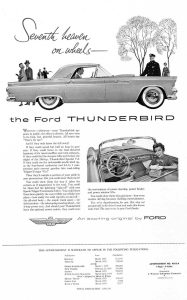
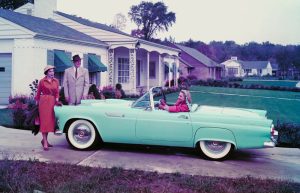
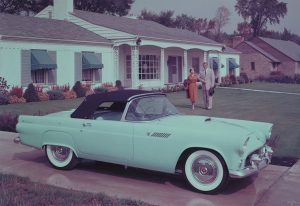

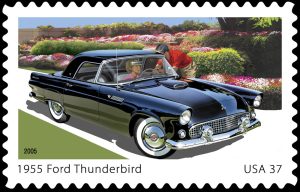


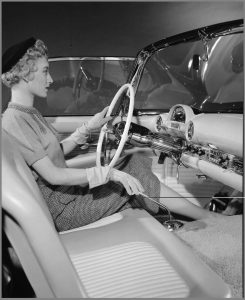
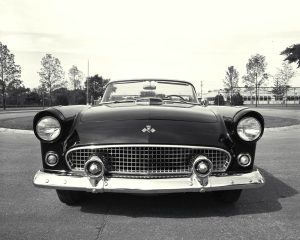

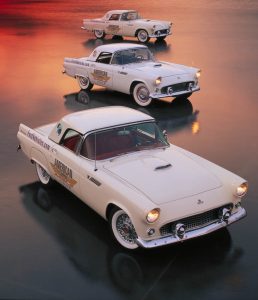

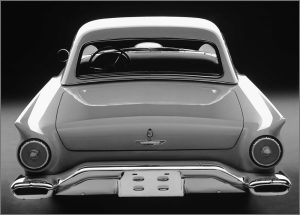


You must be logged in to post a comment.